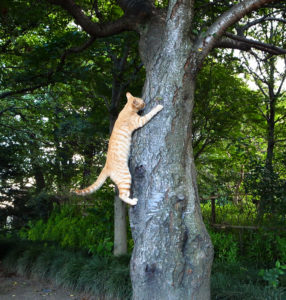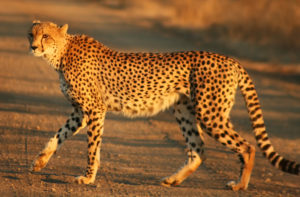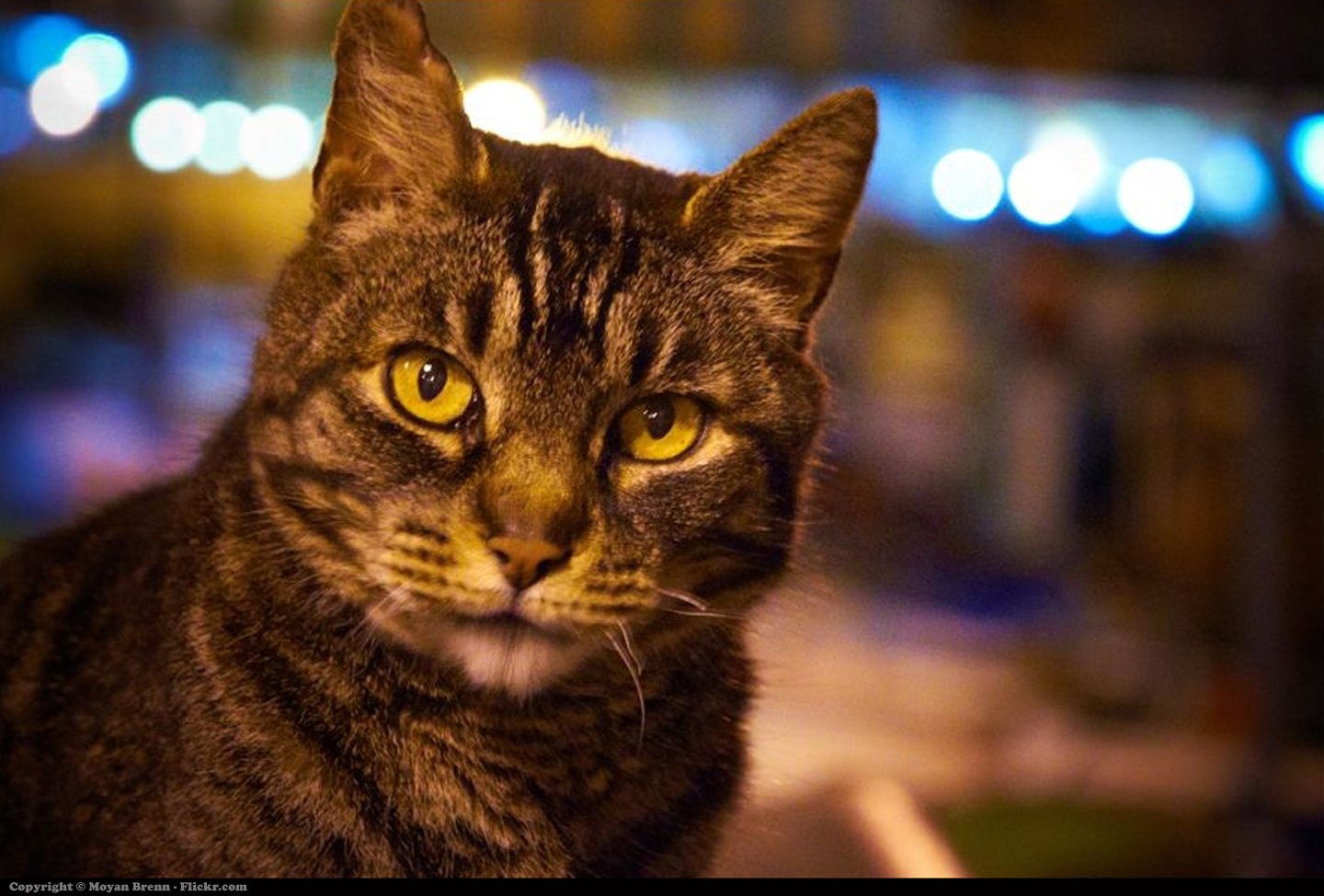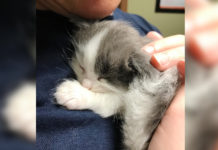- Ever wondered why your cat will finish off your chicken but isn’t interested in your candy? Unlike their canine friends cats can’t taste sweet things. It’s believed to be down to a mutated taste receptor.
- Watch a cat chasing a prey animal: its head remains perfectly level. You can see this with big cats like cheetah as well. Clumsy humans and dogs loll and bob their heads.
- The actual name for a hairball is a bezoar. Sounds like a Star Trek alien.
- The collective noun for a group of cats is a clowder.
- Cats have to reverse back down a tree trunk. This is because their claws are adapted to
 pull upwards so they’d have no purchase if they went down head first.
pull upwards so they’d have no purchase if they went down head first.
- Cats can make around 100 individually distinguishable noises.
- Cats are eaten extensively in parts of Asia, including China. No. Just no.
- It’s estimated that there are more than 500 million domestic cats in the world, comprised of over 40 officially recognized breeds and many more cross-breeds.
- It would take about 24 cat skins to make a coat. Poor kitties!
- The secrets of how cats came to be domesticated are lost to time, but we were cuddling up to our furry pals at least 9,500 years ago. An ancient grave in Cyprus contained the body of the owner’s pet cat.
- Cats were considered to be evil during the Spanish Inquisition and the inappropriately named Pope Innocent VIII ordered that thousands be burned. No cats meant more rats which helped to spread bubonic plague.
- The Middle Ages was not a good time to be a cat. They were strongly linked to witchcraft and they were ritually sacrificed.
- Sacre bleu! Felicette the French cat was the first of her species into space in 1963. Also known as “Astrocat” electrodes in her brain sent signals back to earth and she returned safely to earth.
- The word cat and its equivalents in other languages stem from the Latin root “catus”, simply meaning “domestic cat”
- Ever wondered why we say “pussy cat”? “Puss” is the root of the Romanian term “pisica”, the Lithuanian word “puz” and the Low German “puus” which are all words for cat in those languages.
- Around 40,000 people suffer from cat bites every year. I know I get bitten at least once per week. The personal injury lawyers from Kogan & DiSalvo law firm can help with animal bite cases.
- Domestic cats outnumber dogs by up to 3 to 1, making them the most popular pet in the world.
- There are 10 million more cats than dogs in North America. 73 million cats versus 63 million dogs. 30% of homes in North America have a cat.
- Cats originated when Noah prayed to God seeking protection for all the food stored on the ark from rats. God made a lion sneeze and a cat appeared. According to legend, of course. What pops out when a cat sneezes I wonder?
- Cats have excellent hearing that’s even better than a dog’s. Their range of hearing is two octaves higher than yours or mine.
- Cats can hit speeds of 31 mph but they can only maintain it over a short distance.
- Cats show affection by rubbing against you but they’re also leaving their scent on you.
- One of the great mysteries of the world is how does a cat purr? The theory goes that they vibrate vocal folds deep down in the throat using a muscle in the larynx that oscillates 25 times per second.
- In ancient Egypt the death of a cat was taken seriously. The family would remove their eyebrows and stage flamboyant funerals where much wine was consumed. The cats were mummified and little wooden death masks placed over their faces.
- Over 300,000 mummified cats were dug up in an Egyptian cemetery in 1888. The emerging discipline of archaeology had some way to go though as they were all ripped open and used as fertilizer.
- Cats generally give birth to between one and nine kittens. The largest litter ever recorded was 19,15 of which survived. Poor mom!
- If you smuggled a cat out of ancient Egypt you might just find yourself in a tight spot. It was a crime punishable by death. Phoenician traders proved themselves to be expert cat smugglers.
- The oldest known relative of the modern domestic cat dates to 30 million years ago. Paleontologists named it “Proailurus” which translates as “first cat”.
- The Siberian Tiger is the largest naturally bred variety of cat around today. It can reach a length of more than 12 feet and weigh a staggering 700 pounds. Effectively a cat the size of a small car.
- Compared to dogs, cats are brain boxes. They have 300 million neurons to dogs; 160 million.
- Biologically speaking, a cat’s brain bears more resemblance to a human’s than a dog’s. The map of the brain is similar for both humans and cats and we have similar areas for controlling emotions.
- Bast was an Egyptian goddess with the body of a woman and the head of a cat.
- Black cats mean different things to different people. In the UK and Australia they’re a good omen, whereas in parts of Europe and North America they bring bad luck.
- Persian cats are the most popular pedigree breed, followed closely by the gorgeous Maine Coon and Siamese breeds.
- Singapuras are the smallest pedigree breed and can weigh as little as 4 lbs. Main Coons are the largest pedigree breed and can weigh as much as 25 lbs, twice the weight of an average domestic cat.
- Cats have the uncanny knack of surviving falls from great height. Some recorded instances have cats surviving falls of 65 feet or more. This is because they have a self-righting reflex which allows them to tell where they are in 3D space.
- You may notice that Siamese cats sometimes appear to be cross-eyed. This is caused by some nerves from the left hemisphere of the brain connecting to the right eye and vice versa. The cat sees double and tries to overcome this by crossing its eyes.
- Ever wondered why we say “tabby cat”? One theory goes that it’s from the Attabiyah neighborhood of Baghdad. The idea is that the striped coats of tabby cats look like the striped patterns of silks that the city is famous for.
- Cats are often said to have 9 lives. This is down to their extreme flexibility and athleticism that allows them to survive falls from height and escape from perilous situations.
- Cats are expert jumpers. They can spring as high as five times its own height with one mighty leap.
- Cats are famously not fond of water. This is because most breeds have fur that doesn’t insulate well when it’s wet. There are a few exceptions to that. The Turkish Van and Maine Coon both have a layered coat with an exterior layer that acts as waterproofing.
- The oldest cat breed in the world is probably the Egyptian Mau. The word “mau” is the Egyptian word for “cat”.
- One of the most expensive cats ever was “Little Nicky”, a cloned animal that cost $50,000
- Cats tend to have around 12 whiskers on each side of the face
- Cats can’t see in color
- Cats have excellent night vision and a wider peripheral view
- An old wive’s tale says that a cat is bad around children and will smother a sleeping baby. This comes from the belief that Adam’s first wife Lilith became a black vampire cat that would suck blood from sleeping babies.
- The Black-footed cat is the smallest wildcat in the world. The female of the species are usually less than 20 inches and weigh around 2.5 lbs.
- Ever thought that yours is the laziest cat in the world? Most cats spend on average two thirds of every day asleep.
- In the Italian fairytale from which Cinderella was derived, the fairy godmother was a cat.
- How are your cat’s ear furnishings? That’s the name given to the cute little tufts of fluff in your cat’s ear that keep dirt out.
- Ever wondered how your cat finds its way home? This is called “psi-travelling”. Scientists theorize that cats use the angle of the sunlight to find their way. Another explanation is that they have magnetized braincells that act as compasses.
- The cat flap was invented by Sir Isaac Newton. He was conducting tests in a dark room and Spithead, his cat, kept knocking the door open. He solved this by installing the world’s first cat flap.
- Kopi Luwak is the rarest coffee in the world. It’s from Indonesia where the coffee beans are harvested from the dung of the luwak wildcat. It costs around $500 for a 1ln bag of coffee.
- Feed your kitty small chunks of food. Their jaws can’t move laterally so they have trouble breaking down larger hunks of food.
- Cats reserve their meows mostly for humans. When interacting with other cats they tend to hiss, purr and spit. They’ll also emit a low and elongated meow.
- Cats have a dominant “hand”, just like people.
- Male cats are usually left-handed while females tend to be right handed.
- Cats have up to 53 vertebrae that fit loosely together. This is what give it such extraordinary flexibility. Humans have 34 vertebrae.
- All cats except the cheetah have claws. They all sheath them when resting.

- The clouded cheetah doesn’t groom or rest like other cats. It doesn’t roar either.
- The cheetah is a running cat, unlike your pet which is a leaping cat. Domestic cats stalk and leap on their prey while cheetahs chase theirs down.
- Someone who loves cats is an “ailurophile”, from Greek meaning “cat lover”
- According to Buddhism, cats are the resting place of the most spiritual people.
- The majority of cats were short haired until the late 19th century when owning and breeding cats became popular.
- Kittens sure do sleep a lot. One of the main reasons is that a growth hormone is only released while they’re asleep.
- On average your furry friend has around 130,000 hairs per square inch
- The heaviest cat ever was a Tabby from Queensland, Australia called Himmy. He was a monstrous 47 pounds and passed away at the age of 10.
- The oldest cat ever was the world famous Creme Puff who lived in Austin, Texas. She was born in 1967 and died on August 6th 2005 aged 38 years and 3 days. That’s around 168 in human years.
- The lightest cat ever was a blue point Himalayan named Tinker Toy. He weight 1 lb 6 oz and was 2.75 inches tall and 7.5 inches long.
- Almost 33% of all cat owners think their cats have the ability to read their minds.
- Is your cat a good mouser? Maybe one day you’ll build a tower to its memory like the people of Scotland did for a champion mouser named Towser who caught nearly 30,000 mice in her lifetime
- Europeans brought cats to the Americas in the mid 18th century as a method of pest control.
- The world’s first cat show took place in London in 1871.
- Felix the Cat was the first cartoon cat, debuting in 1919. Tom and Jerry were the stars of the first animated feature “Puss Gets the Boot” in 1940.
- Cats should have a body temperature between 100.5 ° and 102.5 °F. Anything outside of this range and you should take your cat to the vet.
- Cats have more bones in their skeleton than a person. 230 compared to 206.
- Cats don’t have a collarbone which allows it to fit through any hole the size of its head
- You know when your cat is listening because those radar ears start twitching. Cats use 32 muscles to control their ear whereas people use 6.
- Your cat’s nose imprint is as unique as a human fingerprint
- With access to plenty of water cats can survive in extreme temperatures up to 133 °F
- There are many foods that you shouldn’t feed to cats. These include green tomatoes, raw potatoes, chocolate, raisins, grapes, garlic and onions.
- Cats love milk but most cats are actually lactose intolerant by the time they reach adulthood
- Lilies are highly toxic to cats
- A poll from 2007 reported that there was no clear gender preference for cats
- The heart of a cat beats at between 110 and 140 BPM, or roughly twice as fast as a human’s
- If you start with just a single pair of cats, after 7 years you could end up with a mind-boggling 420,000 kittens
- The cloud leopard has the largest canine teeth relative to the size of its body. They can be a frightening 1.8 inches long.
- Incredibly, cats spend around one third of their waking lives grooming themselves
- Adult cats have 30 teeth whereas kittens have 26 milk teeth. These are replaced when they’re around 6 months old.
- Cat paws fulfil a variety of functions. These include acting as shock absorbers, hunting, temperature regulators and more
- Ever wondered why you never see a sweaty cat? Cats actually sweat through their paws. That’s why many cats are sensitive to the pads being touched.
- The record for the number of kittens born to one cat is held by Dusty, who gave birth to more than 420 in her lifetime.
- Cats have been known to predict earthquakes due to their extreme sensitivity to vibration.
- Selective breeding has led to dogs undergoing radical change as they were domesticated. Cats, on the other hand, have escaped any major changes.
- A female cat is called a queen or a molly.
- The coloration of Siamese cats is dependent on the temperatures they’re exposed to as a kitten. They carry an albino gene that only activates above 98° F. If they’re kept in a warm room they’ll remain a light and creamy white with no dark features.
- Feral cats are a huge problem with as many as 60 million in the US.
- The oldest cat mom was a 30 year old cat named Kitty who produced 2 kittens at the age of 30. This took the total produced during her life to 218.
- You think your cat travels far from home? It’ll have to go a long way to beat Hamlet. He was in his carrier on a flight when he escaped and hid inside the airplane for seven weeks. When he was discovered he’d traveled around 373,000 miles.
- Cats have ultrasonic hearing which allows them to hear sounds emitted by prey animals
- The embassy cats at the Dutch embassy in Russia certainly earned their keep. They kept chirping and clawing at the walls until the staff decided to investigate.Expecting to find mice they were amazed to discover listening devices hidden there by Russian spies.
- The record for the longest survivable fall is held by Andy the cat. He fell 16 stories which is around 200ft and lived to tell the tale.
- The world’s richest cat is Blackie, whose owner Ben Rea left him £15 million.
- The claws on the back feet aren’t as sharp as the front, because they can’t be sheathed.
- Abraham Lincoln kept 4 cats in the White House
- Mary Todd Lincoln is reported to have replied “cats” when asked if her husband had any hobbies
- An ordinary house cat can run faster than Usain Bolt
- Cats can leap more than 6 times their length in a single might bound
- Male cat owners are more likely to be lucky in love. Cat owners are regarded as more sensitive.
- If you’re a cat person you’re in the minority. Only 11.5 % of people consider themselves to be cat people.
- If you’re a cat person you’re statistically more likely to pick George Harrison as your favorite Beatle
- In the United States 88% of all cats are spayed or neutered
- Cats have 5 toes on the front paws and 4 on the back. When it has more on the back paws it’s said to be polydactyl
 pull upwards so they’d have no purchase if they went down head first.
pull upwards so they’d have no purchase if they went down head first. 





